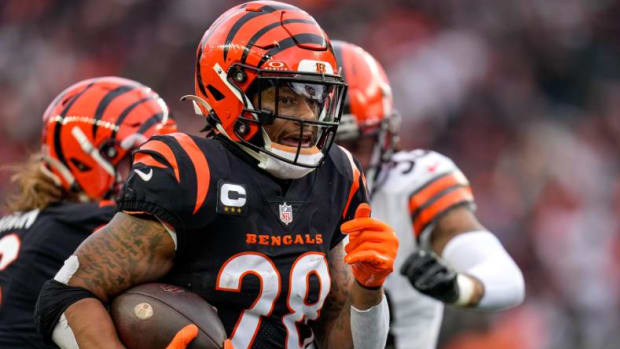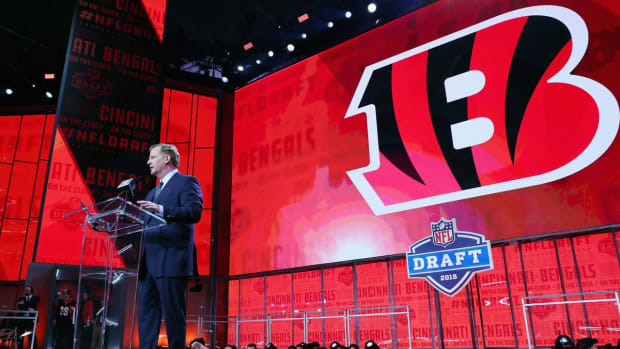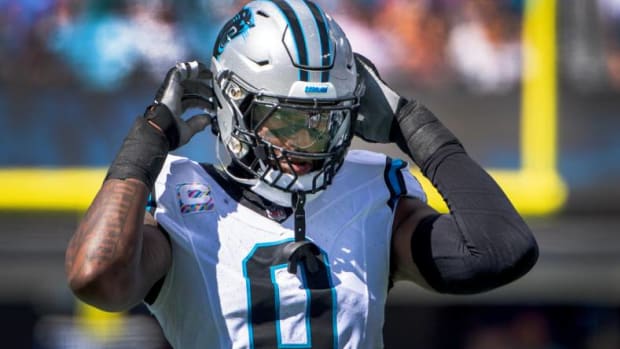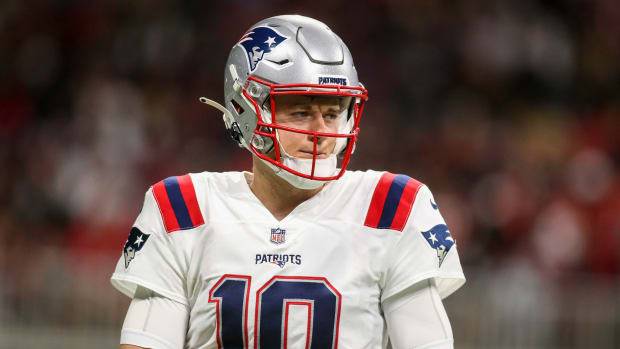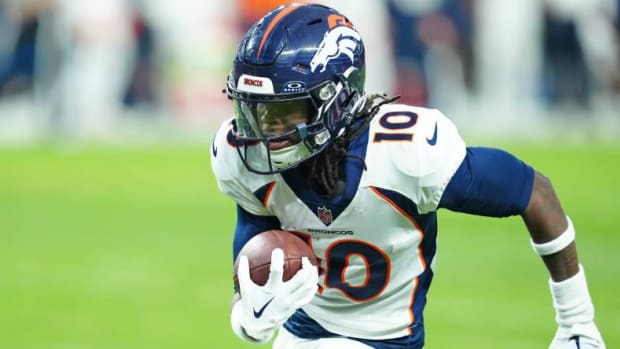Rookie Spotlight: Houston Texans defensive lineman Ross Blacklock
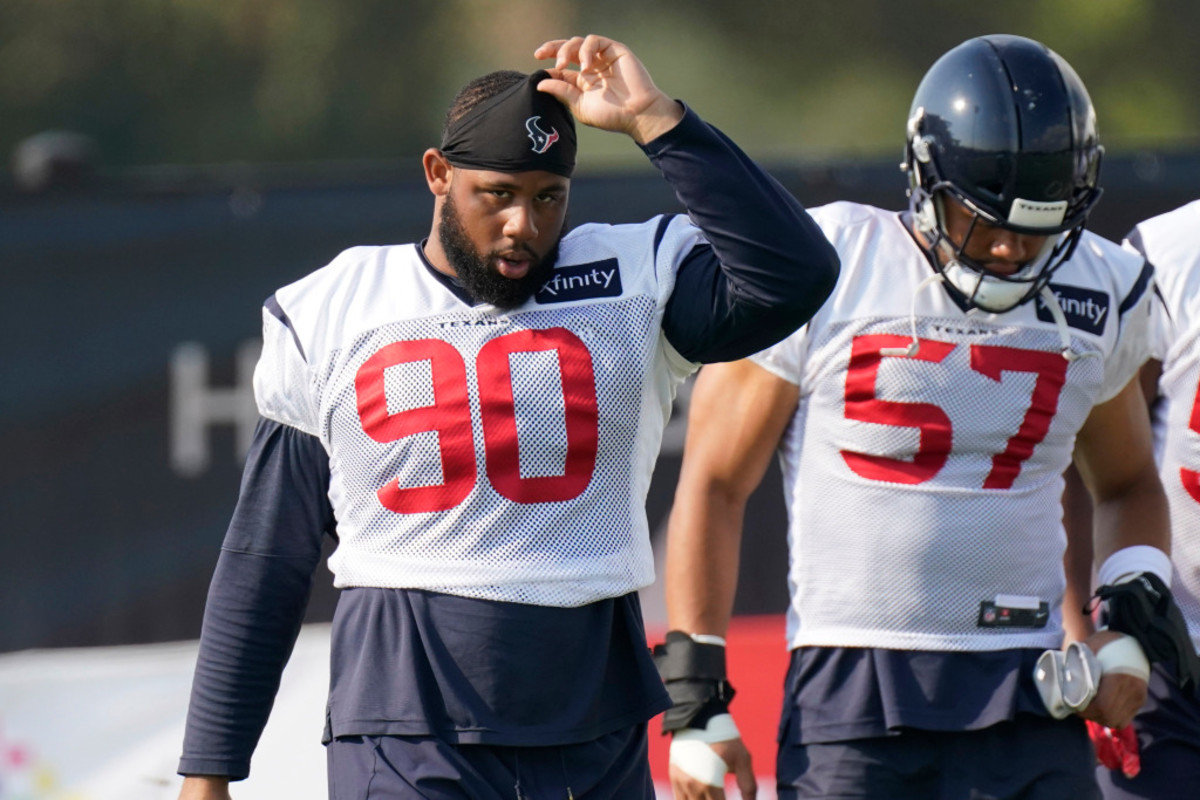
The 2020 NFL Draft class was headlined by potential Pro Bowl-level interior defensive line prospects. Atop the position group was Derrick Brown of Auburn, generally believed to be one of the premier players in the class. After a massive jump in his quality of play from the 2018 season to the 2019 season, Javon Kinlaw of South Carolina entered the conversation for the top defensive lineman in the draft class. It is also worth noting that Raekwon Davis of Alabama received national attention entering the 2019 season due, in part, to his school’s reputation and his high level of play early in his college career. In addition to these three prospects who were certainly worthy of the hype surrounding them was Ross Blacklock of TCU. Generally a lesser-known player to the average fan, Blacklock was in the conversation for an early-round selection throughout the draft process by avid college football followers.
The 2020 pre-draft process that takes place annually following the college football season did not change the consensus opinion on the defensive line class. The first night of the 2020 NFL Draft reflected the widely-held belief that the Auburn and South Carolina stars were the top prospects available at the position. The Carolina Panthers selected Brown with the seventh pick of the draft, while the San Francisco 49ers took Kinlaw with the 14th pick of the draft. No interior defensive lineman would hear their name called again until the eighth selection of the second round when the Houston Texans chose Blacklock.
Despite flying somewhat under the radar among casual fans, the former Horned Frog had a standout career at TCU. Blacklock was an impact player early on, shown by his having won the 2017 Big 12 Co-Defensive Freshman of the Year award. Moreover, he was named a Freshman All-American by the Football Writers Association of America in 2017. His continued success at the collegiate level is exemplified by his award-winning 2019 season. As a junior, Blacklock was named First-Team All-Big 12 by conference coaches and Second-Team All-Big 12 by the Associated Press.
Clearly a talented player, as is evidenced by his draft stock, the college star’s distinguishing traits were his movement skills. Blacklock had excellent burst out of his stance and was able to move cleanly in every direction. He used his quickness and change of direction to get into opposing offensive linemen’s chests or otherwise around them entirely. The TCU star was also able to shoot gaps and penetrate thanks to his explosive first step.
Athleticism is particularly effective when complemented with technical refinement. Blacklock was consistently able to capitalize on his quickness and burst with active and accurate hands. The defensive tackle was able to swipe blockers’ hands away which allowed him to help him initiate contact on their frame. Moreover, he had an impressive array of hand moves at his disposal. Most notably, he excelled with his swim and push-pull moves. Blacklock’s ability to complement his strengths with other positive traits in his game was further exemplified by his use of leverage at the point of engagement. Just as he capitalized on his quickness with his hands, The Frogged Horns’ star defensive tackle enhanced the power and efficacy of his hand moves by entering the point of contact with a naturally low pad level.
While power was certainly not his best trait, the junior was able to translate his leverage and short-area burst into effective power moves. Specifically, Blacklock boasted a dangerous speed-to-power move that he employed by getting into a blocker’s chest with his quickness before using leverage and leg drive to walk them back. Additionally, the All-Big 12 player had a strong upper body which allowed him to bench press or push-pull blockers.
Although his movement skills, refined hands and power earned him notoriety as a pass rusher, the junior defensive tackle was a more-than-sufficient run defender. He was able to read the mesh point and follow the ball-carrier through traffic. What’s more, Blacklock had sufficient power throughout his frame at the college level to anchor down and eat space. Similarly, TCU’s defensive centerpiece had the upper body strength to stack blockers before shedding them with opportunistic timing. Blacklock was generally effective at the tackle point as well, limiting yards after contact.
On top of his athletic traits and nuanced play, the 2017 Big 12 Co-Defensive Freshman of the Year generally had impressive instincts and awareness to diagnose plays. In addition to tracking the ball-carrier through traffic in the run game, Blacklock had a knack for identifying and chasing down screens.
Despite having a strong college career and an impressive skill-set, the Horned Frog did not lack flaws as a prospect. First and foremost, Blacklock was undersized for an interior defensive lineman, at just 6’3” and 290 pounds. Similarly, the defensive tackle’s 32 ⅜” arms at the 2020 NFL Combine are below the desired number for players at the position. The junior’s impressive on-film athleticism was also called into question by a poor performance in virtually every test at the Combine. Furthermore, the standout defender had a questionable injury history, having missed time in his college career with both an Achilles injury and a pectoral injury.
On top of his underwhelming measurables and concerning set of past injuries, the TCU star struggled at times with the mental aspect of the game. While he was generally a smart player, there were too many instances where Blacklock was slow to process or diagnose plays. What’s more, he tended to take some plays off. Additionally, Blacklock did not consistently exhibit sufficient situational awareness, committing a particularly costly targeting penalty against West Virginia in 2019.
Similar to his inconsistent play recognition, the junior’s notable hand usage was too often undermined by his apparent lack of a pass-rush plan and in-game processing. Blacklock was significantly less effective when his first pass rush move did not work. His hand usage tended to fade as the play wore on and he could, as a result, struggle to shed blocks. When he did disengage from blockers, he sometimes did so in a way that would take himself out of position to make a play. Blacklock also struggled at times against the run by losing discipline and creating space for the ball-carrier.
As impressive as the young defender was in terms of using his strengths to enhance each other, he also had weaknesses that directly impacted his best traits. For example, Blacklock tended to explode out of his stance too quickly. In doing so, he extended past his center of gravity and got off balance. This would typically result in his being blocked to his knees. Moreover, Blacklock’s natural leverage and low pad level thanks to his shorter frame were too often counteracted by his tendency to play high. This gave blockers the opportunity to initiate contact and land substantial punches to the young defensive tackle’s chest.
All in all, the TCU product simultaneously had appealing and concerning aspects of his play. That being said, his enticing athleticism and hand move arsenal made him deserving of the 40th overall selection in the 2020 NFL Draft and served as notable reasons for optimism regarding his future in the league.
After Houston traded away its first-round pick, the young defensive tackle was the first player the Texans selected in the 2020 NFL Draft. With this honor came high expectations. After a tumultuous offseason limited by COVID-19 and the accompanying safety restrictions, Blacklock’s preparation time with his new team was limited.
In 16 regular-season games, the second-round pick had a statistically underwhelming year. Blacklock played in each game but started in just one - the Week 17 matchup with the Tennessee Titans. He also saw his season-high in percentage of defensive snaps played in Week 17, at 49%. Before his first start in the season’s final week, the second-round rookie had never played more than 39% of the team’s defensive snaps in a game. By the end of his rookie year, Blacklock had accumulated 14 total tackles and two hits on the quarterback. He did not record any sacks. What’s more, he was ejected from the team’s Week Two match-up with Baltimore for unnecessary roughness after he punched an opposing player.
Despite a generally disappointing season, the TCU product has exhibited various reasons for optimism regarding his future in the NFL. The rookie was used in various alignments across the defensive line, a testament to Blacklock’s intelligence and athleticism. Although presumably drafted to serve as a one or three-tech defensive lineman and used in that capacity at times in his rookie year, the second-round pick’s best film came as a five-tech defensive end on run downs and as a zero-tech nose tackle over the center on passing downs. Blacklock’s relative success in these roles should afford him the time to develop into a more complete player.
Aside from his varied usage, the young defensive tackle’s athleticism was the most notable aspect of his game during his rookie year. His first step out of his stance is electric and allows him to shoot gaps and penetrate. Moreover, Blacklock boasts excellent change of direction and lateral movement ability through engagement and in traffic that are indicative of a promising future in the league. The rookie also has notable open-field athleticism that enables him to chase down run plays or even screens. Perhaps the most impactful benefit his movement skills provide, though, is his burst into contact. Blacklock can explode into a lineman’s frame before they are able to initiate contact, which partially mitigates his limited length.
One method of enhancing other traits is by playing with a low pad level, which the former second-round pick is naturally more inclined to do given his height. When Blacklock plays with leverage, he can functionally increase his length, power and anchor. A low pad level also enables the young defensive tackle to reduce blockable surface area and enter into engagement at more favorable angles. In other words, Blacklock is hard to land a hand on when he combines leverage with his excellent athleticism and burst.
While power is not his game, the former Horned Frog is able to convert speed-to-power well, thanks to his movement skills and use of leverage. When Blacklock is given a runway to a lineman, he can approach the point of engagement low and either extend his arms or explode into an offensive lineman’s chest to initiate contact. The momentum with which he attacks blockers can force them off balance and onto their heels. Blacklock is particularly effective with this move when lined up over the center. The undersized TCU product compensates for his shortcoming by using his best trait - quickness - to create functional power.
In watching Houston play this year, their top draft pick’s hustle and effort on every snap were evident. The young defensive tackle regularly worked to chase down tosses and screens from the backside. Similarly, Blacklock consistently attempted to work through blocks towards the ball-carrier against the run.
While his calling card as a prospect was his ability to get after the quarterback, the Texans’ rookie showed promise in run defense during his first season. Blacklock was particularly effective in this capacity when aligned at four or five-tech. From there, he was able to use his quickness and leverage to set the edge and work through blockers. Moreover, the rookie flashed sufficient gap integrity and discipline to work within structure against the run. As a tackler, Blacklock was generally efficient and effective. He was even able to make plays through contact at times, proving he is capable of maximizing his underwhelming length.
Though the rookie has repeatedly exhibited excellent athleticism and has even shown he is adequate in certain roles, Houston’s top pick must improve before he can serve as a consistent contributor at the NFL level. Currently, Blacklock negates his best traits with technical issues that seriously limit his play.
While he boasts impressive quickness and can win when he engages using leverage, the rookie often plays too high. In doing so, he allows linemen to initiate contact and land hands on his chest. As a result, blockers can control him at the point of engagement. This hinders him both against the run and the pass.
On top of his high pad level, the former Horned Frog has not employed his hands as effectively or often as he did at TCU. Blacklock routinely shoots his hands late, which allows blockers to land punches to his chest. Similarly, he can engage with his hands inaccurately. By attacking with high and outside hand placement, Blacklock further surrenders his frame to contact from linemen. Additionally, the second-round rookie has not exhibited creative hand usage. Instead, he consistently attempts to long-arm his opponents and use his athleticism to win on a play-to-play basis.
One of the most notable concerns with the TCU product’s play is his lack of power and strength to withstand and work through contact. Without any momentum to convert speed-to-power, Blacklock is generally ineffective in a full-man relationship. He struggles to churn his legs through blockers and is too often stopped dead in his tracks or even driven back. As a result, he can be kicked out of gaps in the run game or locked up in his pass rush. Similarly, he is regularly beaten by double teams.
While the young defender has flashed strong gap integrity against the run, there are too many plays where he is forced out of a gap or is ostensibly unaware of his responsibility. His being kicked or sealed out of holes is largely connected to the issues related to his power and length. His lack of discipline in run defense, though, is a mental error that must be fixed. Blacklock tends to remove himself from a hole by working too far upfield as a gap shooter. On other snaps, the rookie seemingly abandons his assignment to chase the ball-carrier down.
These concerns surrounding his play should not be seen as necessarily limiting his NFL projection. Blacklock’s athleticism and knowledge of how to use his movement skills and leverage to manufacture functional length and power cannot be overlooked. That said, the rookie must become more consistent in capitalizing on his strengths while simultaneously refining his game to eliminate those weaknesses that directly contradict his best traits.
A team’s top draft selection is typically expected to start and contribute during their rookie year. Although he started just one game and was inconsistent during his time on the field, Blacklock displayed potential during his first professional season. The rookie is an incredible athlete; however, he must add nuance and technique to his game. With additional coaching and experience, the TCU product may be able to refine his game. Furthermore, the rookie can, for the first time, look forward to a complete offseason with the team. If the Houston Texans’ new coaching staff uses Blacklock situationally as a defensive end on run downs and a nose tackle on passing downs, they will be able to capitalize on his athleticism and talent while he develops into a complete interior defensive lineman.
It is too soon to disregard this talented rookie. While Ross Blacklock’s underwhelming season is certainly notable, he has the physical skill-set to become a starter in the NFL.
For a more in-depth read on his strengths and weaknesses in college, below you can read my 2020 NFL Draft scouting report on Ross Blacklock based on his play at TCU:
STRENGTHS
Although on the smaller side for his position, the TCU product played with a pretty athletic, muscular, athletic build.
A defensive lineman’s mentality and instincts are crucial to their success. Blacklock has shown that he has a good feel for the game. He can find the ball-carrier well through traffic. Moreover, he has displayed the awareness and movement skills to diagnose and track down screen plays. He complements his play recognition with a high motor that makes him a threat to chase down almost any play, within reason.
At roughly 290 pounds, the Horned Frogs’ defensive lineman is very flexible and fluid throughout his frame. Blacklock’s lower body is particularly loose. He can operate at impressive shin angles to the point where his lower body is almost separated from his upper body. This allows him to capitalize on his natural leverage.
Athleticism and movement skills are the TCU product’s top traits. Blacklock is extremely explosive out of his stance and through contact. His first step allows him to consistently penetrate by shooting gaps. He boasts strong change of direction ability through engagement and can, consequently, shed blocks with his agility. Blacklock also uses his impressive lateral quickness in traffic to evade blocks. In space, the Texas native is an excellent mover. This allows him to chase down outside runs and screens. Similarly, his movement skills enable him to work stunts both as the looper and the crasher.
The young defensive lineman can complement his athleticism with strong hand usage. Blacklock has active hands and a diverse set of pass rush moves that he uses to disrupt the pocket or get to the quarterback. When penetrating, the 2019 First-Team All-Big 12 defensive lineman has the ability to work under blockers' arms, reduce surface area, and rip his way into the backfield. Alternatively, the junior uses his leverage and quickness to get into a blocker’s frame and initiate contact. Blacklock’s best moves are his swim move and a push/pull move once he has gotten into a lineman’s chest.
Although it is not his best trait, the 2017 Big 12 Co-Defensive Freshman of the Year is able to manufacture power by combining leg drive, quickness and leverage. Specifically, TCU’s junior defensive lineman uses his burst and low pad level to get into a blocker’s frame before churning his legs to work through contact. In other words, he has an effective speed-to-power move. Blacklock also has a strong upper body and can control linemen if he can land hands on their chests.
While his best plays come as a pass-rusher, the standout defender is effective against the run. Blacklock reads the mesh point well and is regularly able to identify and follow the ball-carrier. Despite his smaller size, the Horned Frog occupies space well thanks to his sufficient anchor. He achieves this power by engaging with leverage and a low pad level. Blacklock is even able to reduce blockable surface area and ostensibly melt through double teams and into the backfield. What’s more, the defensive standout uses his strong upper body to stack blocks at the point of engagement. At the tackle point, Blacklock is a consistent and effective tackler.
WEAKNESSES
An excellent athlete on film, the TCU product’s performance at the Combine should raise questions about his ability to distinguish himself physically at the next level. In addition to underwhelming testing, Blacklock measured in with just 32 ⅜” arms.
Although he is generally a smart player who has shown that he can read and diagnose plays, he needs to process more consistently. Moreover, Blacklock can lose track of the situation and commit unnecessary penalties. For example, he committed a targeting foul during the game against West Virginia (2019). Similarly, Blacklock seems to rely on his athleticism at times and can even take plays off.
While there are certainly extended stretches of refined hand usage on the TCU defender’s film, he can sometimes seem as though he does not have a pass rush plan. Blacklock must be more effective and active if his initial move does not work. Currently, his hand work can fade if his first move is unsuccessful.
Against the run, the young defensive lineman has struggled to shed blocks. When he does disengage, he can do so in the wrong direction and effectively remove himself from the play. Similarly, Blacklock can lose discipline against the run and abandon his gap.
There are even instances against the pass where the TCU product can lose control. There were plays on film where Blacklock became overeager and would burst out of his stance so violently that he extended himself past his center of mass and ended up on his knees.
A shorter defensive lineman’s best advantage can be their pad level. Blacklock is naturally able to play with leverage because of his 6-foot-3 frame. He tends to have too many plays where his pad level is too high. This limits the impact his movement skills can have.
The 2020 NFL rookie class had a turbulent transition to the professional game, as their first offseason was marred by COVID-19. This likely set their development back by at least one season. It is now clear that Houston’s second-round pick likely would have benefited from this additional time with his new team after he struggled in his first year in the league. That being said, he showed promise. With coaching and experience, Ross Blacklock may still develop into an impact player in the NFL.
Be sure to check back for next week’s Rookie Spotlight article for a deep dive into Indianapolis Colts wide receiver, Michael Pittman Jr.

